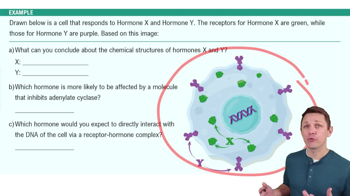A woman begins a diet and exercise regimen and loses 30 lb. Will her total body water increase, decrease, or stay the same? Why?
 Erin C. Amerman 2nd Edition
Erin C. Amerman 2nd Edition Ch. 25 Fluid, Electrolyte, and Acid-Base Homeostasis
Ch. 25 Fluid, Electrolyte, and Acid-Base Homeostasis Problem 25.3a
Problem 25.3aExplain how the amount of water in the body affects the concentration of ions and solutes in the ECF.
 Verified step by step guidance
Verified step by step guidance
Verified Solution
Key Concepts
Extracellular Fluid (ECF)

Osmolarity
Homeostasis

What do you think has happened to Elise's ECF volume and osmolarity over the past 3 days? Will this lead to a change in the volume of water in the cytosol of her cells? Explain.
What happens to the pH of a solution when hydrogen ions are added?
a. The pH increases.
b. The pH decreases.
c. The pH does not change.
d. The pH does not measure hydrogen ion concentration.
Ms. Johanssen is a patient in the hospital. The nurse examines her laboratory reports and notices that she has developed hyperkalemia and acidosis over the past several days. On closer examination of her medical chart, the nurse also sees that her physician recently doubled her dose of spironolactone, an aldosterone-blocking diuretic. How does this explain her laboratory findings?
As a percentage of body weight, the total body water tends to be higher in ________ and lower in ________ .
a. infants; men
b. women; men
c. men; infants
d. infants; women
Diabetic ketoacidosis is characterized by an increased level of ketone bodies, which causes metabolic acidosis. A patient in diabetic ketoacidosis will have an altered rate of ventilation. Will the patient be hyperventilating or hypoventilating? How will a change in the rate and depth of ventilation compensate for an acidosis that is metabolic in nature?